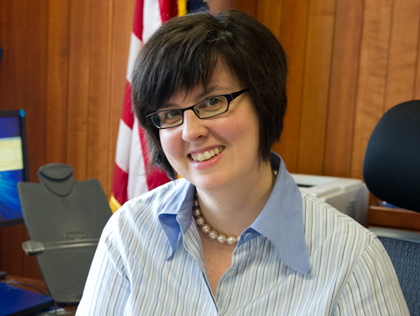

As readers of the last Edge edition know, Assistant Secretary Raphael Bostic has left HUD to return to his faculty position at the University of Southern California. All of us here in PD&R will miss him greatly, and we hope he enjoys some well-deserved time for relaxation and bird watching on the way back to California. I want to take this opportunity to introduce myself.
First, though, I want to take a moment to acknowledge the important legacy that Raphael left us to build upon. In three short years, Raphael brought PD&R back as a leading voice in the housing and community development field. Some of this is obvious to the outside world, such as the creation of the Administration-wide Housing Scorecard, and major research we are now undertaking on housing discrimination, housing counseling, and rent reforms and asset-building in public housing. He also made a tremendous difference behind the scenes for HUD’s research and analytic capacity, rebuilding and supporting the PD&R network of field economists across the country and supporting and prioritizing PD&R in-house research efforts by PD&R staff. Beyond the traditional purview of PD&R, Raphael often provided balanced leadership essential to many high-profile efforts within HUD and for the White House.
All of us in PD&R are committed to strengthening PD&R’s research capacity and contributions to the field of housing and community development research. At the top of my list is developing a five-year Research Roadmap for PD&R that Raphael wrote about in March. This roadmap will help us plan our work and budget resources to support research, data analysis and other investments that are important to HUD and our stakeholders. No doubt some of you submitted ideas or attended our Research Agenda Conference last fall, or have spoken with the Roadmap team at other meetings and events (and if you haven’t, let us know at PD&RResearchRoadmap@hud.gov — we want to hear from you!).
I am also familiar with a lot of great research happening beyond HUD from my time at the MacArthur Foundation, where I was Associate Director for Affordable Housing. This year, PD&R introduced a new tool that will enable us to partner with researchers that have secured significant support from philanthropy and other government partners. These Research Partnerships will help HUD integrate its work with the wider research community to better advance knowledge and policy.
This column in The Edge, and the other publications of PD&R, are important steps towards keeping PD&R connected to the wider policy world. For the past three years as Deputy Assistant Secretary for Policy Development in PD&R, I have focused on revamping our communication and outreach efforts and as Acting Assistant Secretary I plan to continue building them. As an avid tablet user, I was excited (as I hope many of you are) that we were able to launch the Edge app — an easier way to get the latest from PD&R. Look for more apps in the future!
Finally, I would like to describe one new direction for PD&R that I am especially excited about. I started my policy career in local government — the level that carries out a lot of HUD programs in both housing and community development. HUD, and specifically PD&R, has played a leading role in the interagency Strong Cities, Strong Communities initiative to help build local government capacity in some of the nation’s most distressed cities. In March, we were excited that President Obama signed an Executive Order creating a White House Council on Strong Cities, Strong Communities, to serve as a coordinating body of 19 agencies and sub-agencies pledged to build a better partnership between the federal government and cities. This Council is co-chaired by the Secretary of HUD and the Director of the White House Domestic Policy Council, and will be housed at HUD. The Secretary has chosen to make PD&R the lead within HUD for these efforts, so we will be focusing time and energy on helping the Council begin its work.
We have a lot of work ahead of us, but this is an exciting time in PD&R and at HUD. I’m honored to take over this column and I look forward to sharing some of our work through The Edge over the coming months. Stay tuned.
PD&R Leadership Message Archive
International & Philanthropic Spotlight Archive
Spotlight on PD&R Data Archive
Publications
Collecting, Analyzing, and Publicizing Data on Housing Turnover
Resilience Planning: What Communities Can Do to Keep Hazards from Turning into Disasters
Cityscape: Volume 26, Number 3
Case Studies
Case Study: Former School in Charleston, South Carolina, Transformed into Affordable Housing for Seniors
Case Study: Avalon Villas Combines Affordable Housing and Services for Families in a Gentrifying Phoenix Neighborhood

The contents of this article are the views of the author(s) and do not necessarily reflect the views or policies of the U.S. Department of Housing and Urban Development or the U.S. Government.
Note: Guidance documents, except when based on statutory or regulatory authority or law, do not have the force and effect of law and are not meant to bind the public in any way. Guidance documents are intended only to provide clarity to the public regarding existing requirements under the law or agency policies.



